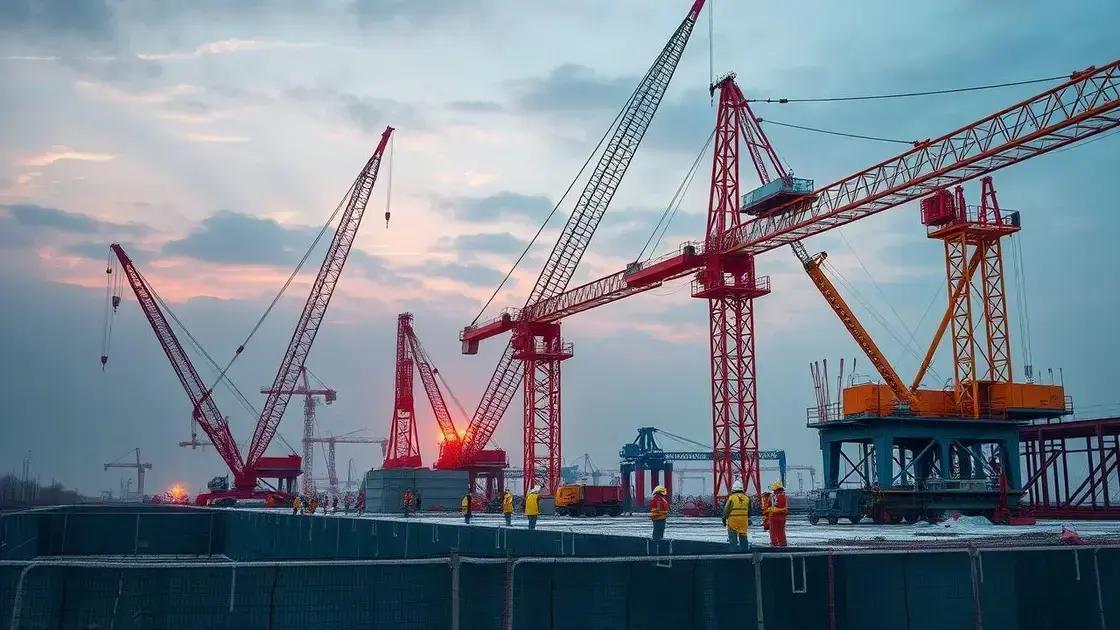Infrastructure project updates: what you need to know

Infrastructure projects significantly impact local economies by creating jobs, increasing property values, enhancing business accessibility, and improving public services, ultimately fostering community growth and stability.
Infrastructure project updates can greatly influence our daily lives. Want to know how these updates might affect your community? Let’s dive into the latest changes and developments, all while highlighting the importance of these projects in shaping our future.
Current trends in infrastructure projects
Understanding the current trends in infrastructure projects is crucial for staying ahead in a rapidly evolving landscape. With technology advancing and communities growing, these projects are more important than ever.
Innovative Technologies
One major trend is the integration of innovative technologies. Modern infrastructure projects now utilize:
- Smart sensors for monitoring conditions
- Building Information Modeling (BIM) for efficient planning
- Green technologies to promote sustainability
These advancements help improve efficiency and minimize environmental impact. As we shift towards smarter cities, technology is becoming integral in shaping our infrastructure.
Sustainable Practices
Another trend gaining momentum is the emphasis on sustainability. Infrastructure projects are increasingly focused on:
- Reducing carbon footprints
- Utilizing recyclable materials
- Incorporating renewable energy sources
This focus reflects a growing awareness of the environmental challenges we face, pushing developers to create more sustainable solutions that benefit communities.
Moreover, public investments in infrastructure are also on the rise, driven by the need for enhancements in transportation and utilities. These investments not only create jobs but also improve the quality of life for residents. With an increased focus on equity, many projects are designed to address the needs of underserved communities, ensuring that all citizens benefit from new developments.
As infrastructure projects evolve, understanding these trends will help communities better prepare for what lies ahead. Keeping an eye on advancements in technology and sustainability can lead to informed decisions that positively impact our future.
Key benefits of infrastructure updates
The key benefits of infrastructure updates are clear and significant. As communities evolve, these updates play a vital role in enhancing everyday life.
Economic Growth
One major advantage is the potential for economic growth. Improved infrastructure leads to:
- Increased job opportunities
- Enhanced business productivity
- Attracting new investments
When infrastructure is improved, businesses can operate more efficiently, boosting the local economy.
Enhanced Safety
Another crucial benefit is enhanced safety for residents. Updated roads and bridges can significantly reduce the risk of accidents, making transportation safer for everyone.
Properly designed infrastructure also helps prevent hazards such as flooding and provides better access to emergency services. Modernized systems can lead to quicker responses during emergencies, protecting communities better.
Furthermore, these updates contribute to improved quality of life. Enhanced public services, such as reliable transportation and utilities, increase residents’ comfort and satisfaction. With better roads, citizens spend less time in traffic, leading to a more efficient day-to-day life.
Housing and urban development benefit as well. Updated infrastructure can lead to revitalization projects that strengthen neighborhoods and create welcoming spaces. New parks, community centers, and transportation links can foster a sense of connectedness and pride among residents.
As we continue to see changes in our world, it’s essential to recognize the significant benefits that come with infrastructure updates. These improvements not only affect individuals but contribute positively to the community as a whole.
Challenges faced in project implementations

Infrastructure projects often encounter various challenges during implementation. Recognizing these hurdles helps stakeholders navigate the complexities involved.
Budget Constraints
One of the most significant challenges is managing budgets. Infrastructure updates can be costly, leading to:
- Funding shortfalls
- Unexpected costs due to delays
- Limits on project scope
When budgets are tight, it may be hard to complete projects on time or to the desired standard.
Regulatory Hurdles
Another issue is navigating through regulatory requirements. Different regulations can slow down projects as teams work to meet:
- Environmental standards
- Local zoning laws
- Safety codes
These regulations, while important for safety and compliance, can introduce delays that affect overall project timelines. Failure to comply can also result in fines or project revisions, adding complexity to implementations.
Moreover, community opposition can emerge, impacting progress. Residents may have concerns about disruptions, environmental impacts, or changes to their neighborhoods. As a result, open communication with the community is essential to address worries and build support.
Skilled labor shortages pose another challenge. Many infrastructure projects require specialized workers, and the demand often exceeds the available supply. This situation can lead to delays and drive up costs if companies need to hire from distant locations.
While these challenges can be daunting, understanding and addressing them is key to successful project implementation. Collaboration between governments, contractors, and communities can create solutions that work for everyone.
Upcoming infrastructure projects to watch
As we look ahead, several upcoming infrastructure projects are worth watching. These projects promise to reshape communities and improve everyday life.
Transportation Enhancements
One exciting area of development is transportation. Cities are investing in:
- New highways to ease traffic congestion
- Expanded public transit systems to connect neighborhoods
- Bike lanes and pedestrian walkways for safer travel
These projects aim to improve mobility and reduce travel times for residents.
Sustainable Energy Initiatives
Another key trend is the focus on sustainable energy. Many regions are planning:
- Solar farms to harness renewable energy
- Upgrades to electrical grids for better efficiency
- Wind energy projects to reduce dependence on fossil fuels
These initiatives are critical in fighting climate change while also creating green jobs for local economies.
Additionally, water infrastructure is seeing significant attention. Upgrades to water treatment facilities and pipelines are essential for ensuring safe drinking water. Many cities are investing in systems that reduce leaks and provide reliable access for all residents.
Community development projects are also on the rise. Revitalizing parks, recreation centers, and public spaces fosters community engagement and enhances quality of life. These improvements help create vibrant, welcoming neighborhoods that residents can enjoy.
Keeping an eye on these upcoming infrastructure projects allows communities to prepare for the impacts they will have. Engaging with local stakeholders ensures that these developments meet the needs of all residents, fostering a more connected and thriving society.
The impact of infrastructure on local economies
The impact of infrastructure on local economies is profound and multifaceted. Good infrastructure fosters growth and enhances the quality of life for residents.
Job Creation
One of the most direct effects is job creation. New infrastructure projects often lead to:
- Construction jobs that boost local employment
- Permanent jobs in maintenance and operations
- Opportunities in related industries such as manufacturing and services
As jobs are created, local businesses benefit from an increased customer base.
Increased Property Values
Another significant effect of infrastructure development is the increase in property values. The creation of new roads, public transport, and amenities can make neighborhoods more desirable, leading to:
- Higher home values for current residents
- Increased tax revenues for local governments
- Greater investments from developers
As property values rise, the overall wealth of the community can improve, allowing for better public services.
Additionally, infrastructure enhances accessibility. Improved transportation networks make it easier for businesses to reach customers and suppliers. This connectivity allows local businesses to expand their markets and access resources more efficiently. It can also attract new businesses to the area, further stimulating the economy.
Moreover, a well-planned infrastructure can lead to better education and healthcare services. Communities with upgraded schools and healthcare facilities retain residents and attract new ones, thereby reinforcing economic stability and growth.
Understanding the impact of infrastructure enables policymakers and stakeholders to prioritize investments that deliver long-term benefits. Developing and maintaining infrastructure is essential for fostering thriving local economies.
In summary, infrastructure projects significantly impact local economies. They drive job creation, enhance property values, and improve accessibility. Furthermore, they contribute to better public services in education and healthcare. Investing in infrastructure is essential for fostering growth and ensuring community well-being. By understanding these benefits, we can support initiatives that create vibrant, thriving communities.
\n\n\n
\n
\n
FAQ – Frequently Asked Questions about Infrastructure and Local Economies
How do infrastructure projects create job opportunities?
Infrastructure projects require a significant workforce, leading to job creation in construction, maintenance, and related industries.
What is the effect of infrastructure on property values?
Investing in infrastructure typically raises property values, making neighborhoods more desirable and attracting new investments.
How does improved infrastructure benefit local businesses?
Better infrastructure enhances accessibility, allowing businesses to reach customers more easily, thereby expanding their market and increasing sales.
Why is public service enhancement important in infrastructure projects?
Improvements in infrastructure lead to better education and healthcare services, resulting in a higher quality of life and economic stability for communities.






